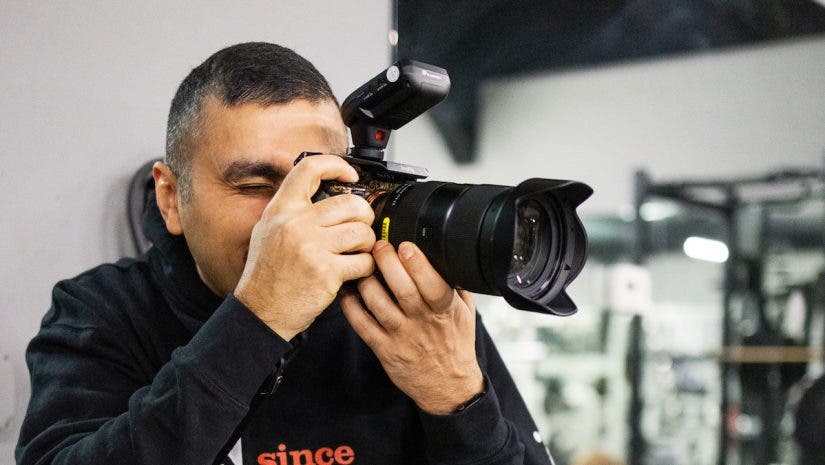Zoom lenses are useful for their ability to be versatile and convenient. A zoom lens give photographers and cinematographers access to multiple focal lengths in a single lens. They’re also great for simplifying your workflow, and reducing the amount of lenses you carry to a shoot. Tamron has a revolutionary zoom lens for Sony E-Mount cameras — the Tamron 35-150mm f2-2.8 Lens — which we will be examining in this article.
The Tamron 35-150mm f2-2.8 Lens combines a versatile range of focal lengths and apertures that has never been available for the Sony E-Mount system. The best part is — although it’s designed for Sony Full Frame bodies like the flagship Alpha 1, a7 IV, and others — it’s still compatible with Sony’s range of APSC and Cinema cameras, like the Alpha A6600 and FX3. This is thanks to Sony’s “One Mount” E-Mount system. This system allows you to purchase one lens and use it across all of Sony’s full frame, APSC, and professional lineup of cinema cameras.
About Zoom Lenses
Zoom lenses are available in a wide variety of focal lengths and maximum apertures. They can range from premium fixed aperture options to more affordable variable aperture zooms.
Professional fixed-aperture zoom lenses are usually constant aperture lenses that remain at f2.8 throughout the focal range. They are offered in “normal” 24-70 mm or “telephoto” 70-200mm focal lengths. In contrast, enthusiast-level zoom lenses typically offer fixed apertures at f4 in a few classic focal lengths — like 16-35mm, 24-105mm, and 70-200mm. Budget friendly options usually offer variable apertures that start at f5.6, have focal lengths that cover everything from normal to telephoto. They are also typically offered as bundled kit lenses, or sold as inexpensive alternatives to premium and enthusiast level zooms. Although, the Tamron 35-150mm f2-2.8 Lens is truly a step above the rest.

Key Features of the Tamron Lens:
- 35-150mm zoom range, with best-in-class f2-2.8 variable aperture
- 9 rounded blade aperture diaphragm blades for smooth bokeh
- 21 elements in 15 groups for optical design
- Mirrorless lens for fast hybrid autofocuc using VXD linear motors, supporting Sony’s Eye AF, Tracking Autofocus Focus, DMF, and in-camera corrections
- 13” minimum focus distance for excellent macro reproduction at 1:5.7
- Tamron Lens Utility software allows direct customization of A-B Focus, Focus Preset, Focus RingFunctions, and firmware updates via included USB-C port
- Weather sealed mount and body, weighing in at 2.57 lbs
- Includes zoom lock switch for protection during travel
- Front element includes Fluorine coating for protection and safe cleaning
- Physical buttons are customizable, and include focus hold button, AF/MF switch, and three custom mode switch buttons for preset custom modes
- 82mm front filter size with locking hood
One Lens That Can Do It All
I’ve been using the Tamron 35-150mm f2-2.8 Lens exclusively for all of my work over the past month. It’s been the only lens that I’ve mounted on my Sony Alpha 1 for many creative shooting assignments. I’ve used it for landscapes, portraits, lifestyle shots, commercial assignments, and traveled with it to Los Angeles.
After using it for a wide range of deliverables, I can say it really is the all-in-one lens I’ve always wanted. It offers the best of two workhorse zoom lenses that I used to carry for all of my wedding and commercial work.

The Tamron 35-150mm lens offers most of the focal lengths from 24-70mm and 70-200mm, with only 24-35mm and 150-200mm being left out of the range. Loosing those focal lengths didn’t impact any of my work over the past month. I could easily compensate at the wide end by physically backing up. I could also compensate at the long end by cropping into my high resolution, 50 megapixel, Sony A1 files.
The Tamron 35-150mm lens offers a better aperture range. It is more versatile than both of the G-Master zoom lenses that I used to carry. This is all while minimizing the amount of gear I need to manage and increasing my efficiency by improving my workflow.
Here are the focal lengths and variable apertures of the Tamron 35-150mm f2-2.8:
- 35mm at f2
- 50mm at f2.2
- 70mm at f2.5
- 85-150mm at f2.8
Image Quality, Sharpness, and Focusing
The Tamron 35-150mm lens provided professional-level native performance throughout my month of extended use. Regardless of the shooting scenario or lighting conditions, the focusing was fast, quiet, and accurate — even when shooting directly into the sun. It held its contrast and color really well in challenging lighting conditions.

The Tamron 35-150mm lens performed as good as my other native Sony lenses. I didn’t encounter any focus hunting, chromatic aberrations, or softness across the frame. The nine rounded aperture blades render beautifully soft bokeh. When combined with the compression that it provides at the long end of the focal range, it really is a dream lens for portraits and compressed landscapes.

The one thing to note is that the Tamron 35-150mm f2-2.8 does not offer Sony’s Optical Steady Shot (OSS) which is a lens-based optical stabilization system. I personally didn’t encounter any soft images due to the lack of OSS. My Sony A1 compensates for any handheld shake, using its in-body image stabilization (IBIS), which is a sensor-based stabilization system.
Creators who tend to shoot a majority of their images handheld, and plan to use this lens with camera bodies that do not offer OSS or IBIS, should consider upgrading to a modern Sony body which offers IBIS. Another option is using a sturdy tripod, or looking at other options that have OSS built into the lens.
Build Quality And Customization
The build quality of the Tamron 35-150mm lens is robust and full-featured. The lens is completely weather-sealed at the mount and throughout the body. The contoured design is comfortable to hold, and the textured rubber rings on the zoom and focus rings are rugged. They provide tactile control of focusing and precise adjustments to focal length changes.

There are three custom mode switches on the lens that can be pre-programmed via Tamron’s Lens Utility Software. This allows creators to quickly customize the physical controls of the lens, assign pre-programmed A/B rack focus points, enable linear or non-linear focus controls, and assign custom functions like aperture control to the focus ring, or Eye AF to the focus hold button. The built-in USB-C port on the body is also weather-sealed and allows for convenient firmware upgrades directly from a PC.
I found the Tamron Lens Utility software to be very convenient, as I could quickly and easily make customizations. I could also check for firmware updates without the need to have my camera attached to the lens. The software is easy to use and allows creators to easily customize and personalize the lens to their liking.
For Professionals and Beginners Alike
The Tamron 35-150mm lens allowed me to stay in the moment and capture images during all of my shoots over the past month. I was able to create more conveniently than I could have if I was using multiple prime lenses. I didn’t have to worry about constantly swapping lenses, allowing me to simplify my workflow. This offered me all of the focal lengths that I needed for travel and commercial work.

That’s not to say that the Tamron 35-150mm lens isn’t great for beginners. The same utility and convenience is also available for new photographers who are looking to carry just one lens. Beginners and enthusiasts that are looking for their first Sony lens would benefit greatly by starting with the Tamron 35-150mm lens.
Final Thoughts
The Tamron 35-150 mm lens can replace up to five prime lenses — offering 35mm, 50mm, 85mm, 105mm, 135mm, and 150mm focal lengths. It offers excellent optics, performance, and build quality at less than half of the cost of buying the equivalent five primes.
Over the course of one month, and various shooting assignments, the Tamron 35-150mm lens stayed glued onto the mount of my Sony A1. It was instrumental in allowing me to focus on telling the story, instead of worrying about my gear and being distracted. It’s a unique lens that can do it all, and would be a great lens for professionals and beginners alike.
To learn more about lenses that can help improve your photography, check out our other “Lens In Focus” 42West articles:






